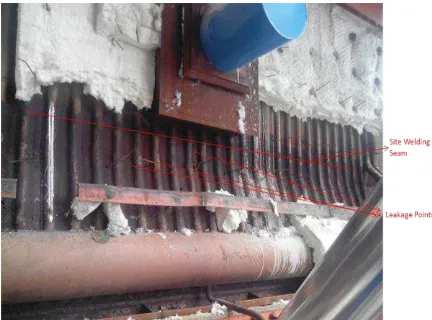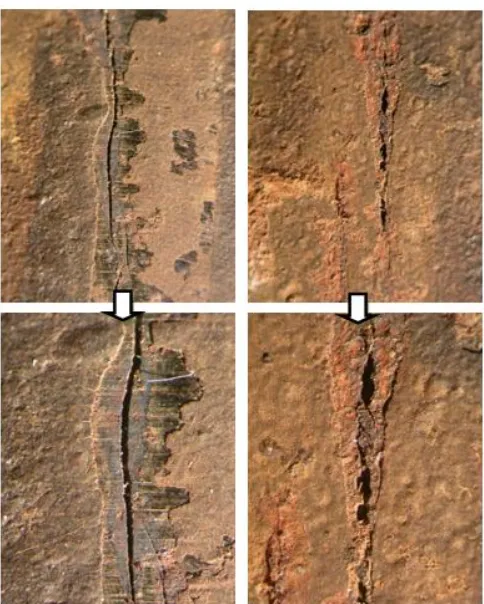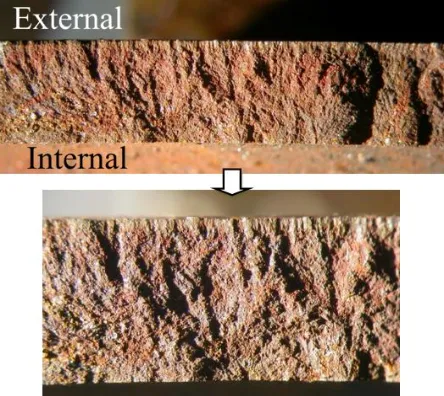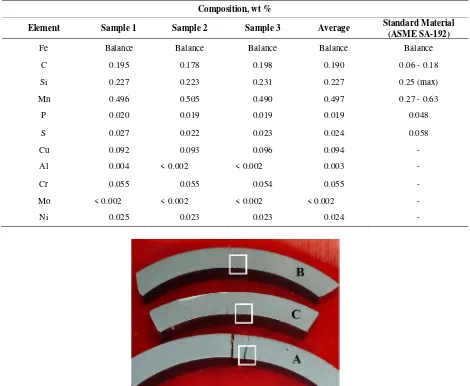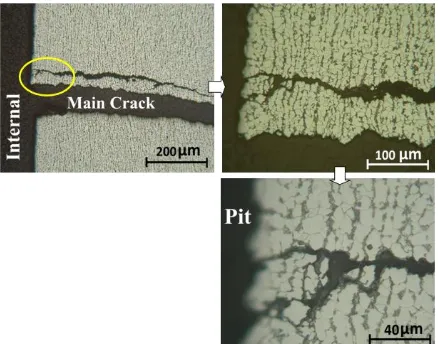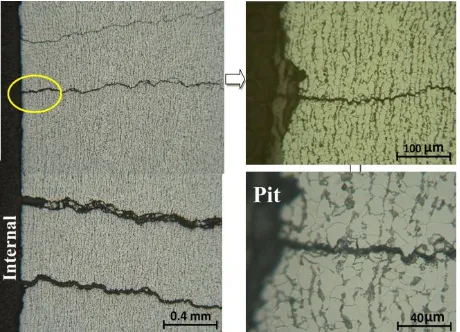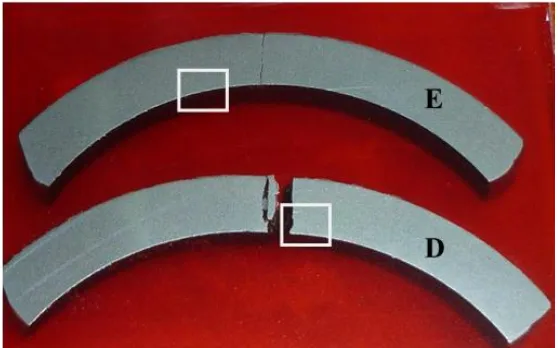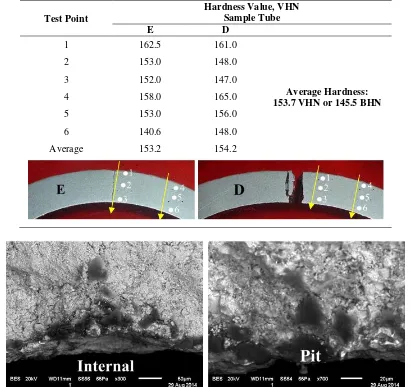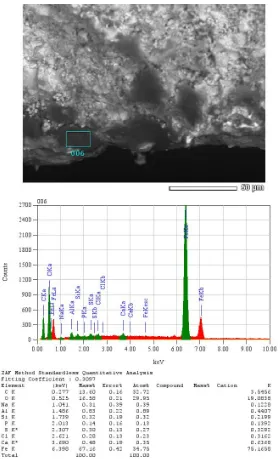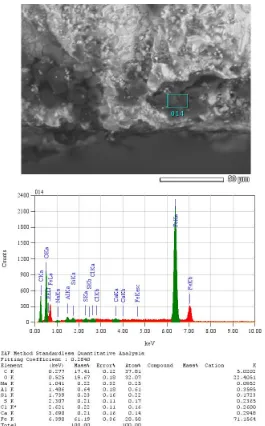Metalurgi (2017) 3: 123 - 136
M
ETALURGI
Available online at www.ejurnalmaterialmetalurgi.com
S
TRESS
C
ORROSION
C
RACKING OF
C
AGE
S
UPERHEATER
T
UBES OF A
N
EWLY
B
UILT
B
OILER
Dewa Nyoman Adnyana
Department of Mechanical Engineering, Faculty of Industrial Technology The National Institute of Science and Technology (ISTN)
Jl. Moh Kahfi II, Jagakarsa, Jakarta Selatan 12640 E-mail:adnyanadn@yahoo.com
Masuk Tanggal : 03-11-2017, revisi tanggal : 26-12-2017, diterima untuk diterbitkan tanggal 08-01-2018
Intisari
Sejumlah pipa penukar panas lanjut pada sebuah ketel uap yang baru dibangun diketemukan bocor selama operasi komisioning yang pertama. Kebocoran terjadi ketika ketel uap baru saja mencapai tekanan 23,7 barg dan temperatur 405 °C dari tekanan dan temperatur operasi yang direncanakan yaitu 53 barg dan 485 °C. Dalam makalah ini dibahas jenis kerusakan dan faktor-faktor yang kemungkinan telah menyebabkan terjadinya kebocoran pada pipa penukar panas lanjut tersebut. Penelitian/pengujian metalurgi telah dilakukan dengan mempersiapkan sejumlah benda uji yang diperoleh dari salah satu potongan pipa yang bocor tersebut. Berbagai pengujian laboratorium telah dilakukan meliputi: uji makro, analisa komposisi kimia, uji metalografi, uji kekerasan dan uji SEM (scanning electron microscopy) yang dilengkapi dengan analisis EDS (energy dispersive spectroscopy). Hasil penelitian/pengujian metalurgi yang diperoleh menunjukkan bahwa pipa penukar panas lanjut yang bocor tersebut telah mengalami retak korosi tegangan yang disebabkan oleh efek kombinasi antara korosi dan tegangan tarik. Unsur korosif yang kemungkinan dapat menimbulkan terjadinya retak korosi tegangan pada pipa penukar panas lanjut adalah kaustik sodium (Na) dan elemen-elemen lainnya pada tingkatan yang relatif rendah seperti Ca, Cl, S dan P.
Kata Kunci: Pipa penukar panas lanjut, retak korosi tegangan, kaustik sodium (Na)
Abstract
A number of cage superheater tubes of a newly built steam boiler have been leaking during boiler’s first start-up commissioning. Leaking occurred when the boiler had just reached a pressure of 23.7 barg and temperature 405 °C from the intended operating pressure of 53 barg and temperature of 485 °C. Type of failure and factors that may have caused the leakage of the cage superheater tube are discussed in this paper. The metallurgical assessment was conducted by preparing a number of specimens from the as received leaked cage superheater tube. Various laboratory examinations were performed including macroscopic examination, chemical composition analysis, metallographic examination, hardness test and SEM (scanning electron microscopy) examination equipped with EDS (energy dispersive spectroscopy) analysis. Results of the metallurgical assessment obtained show that the leaked cage superheater tubes have been experiencing stress-corrosion cracking (SCC) caused by the combined effect of corrosion and tensile stress. The corrosion agent that may have been responsible for the occurrence of SCC in the tube was mostly due to caustic sodium (Na) and other elements in a lesser extent such as Ca, Cl, S and P.
124 | Metalurgi, V. 32.3.2017, E-ISSN 2443-3926/ 123 - 136
1.
I
NTRODUCTIONThe failure of industrial boiler has been a prominent feature in fossil fuel-fired power plants. The contribution of several factors appears to be responsible for failures, culminating in the partial or complete shutdown of the plant. A survey of the literature [1]-[6] pertaining to the performance of steam boilers during the last 30 years shows that abundant cases have been referred to, concerned with the failure of boilers due to fuel ash corrosion, overheating, hydrogen attack, carburization and decarburization, corrosion fatigue cracking, stress-corrosion cracking, caustic embrittlement, erosion, etc.
The majority of forced outages of power boilers are due to premature failure of boiler components [1]-[7]. Boiler tube failures are the main cause of forced outages of power generating units. The contribution of total tube failure can be grouped as furnace water wall tubing 61%, superheater and reheater tubes 20%, and skin casing 19% [7]. The superheater tube is one of the critical components of a power boiler in the production of superheated steam. In this case, an investigation has been carried out on a failed superheater tube in a newly built coal fired power plant. One piece of the failed tube of about 300 mm in length received for conducting the failure analysis. This tube piece was one of a number of cage superheater tubes that had been leaking during
boiler’s first start-up commissioning when the boiler had just reached a pressure of 23.7 barg and temperature of 405 °C (see Figure 1), where the intended operating pressure and temperature of the boiler was 53 bar and 485 °C, respectively. The original outside diameter and wall thickness of the failed tube were 50.61 and 5.12 mm, respectively. The tube was made of ASME SA-192 a standard specification for formation of internal oxidation/corrosion occurring in the tubes.
The purpose of this metallurgical assessment is to verify the material properties and determine whether the material used for the cage superheater tube met the specification or suitable for its operating condition.
Figure 1. Photograph of cage superheater tubes after the accident showing locations of tube leakages
Stress Corrosion Cracking of Cage Superheater Tubes Of A Newly Bulit Boiler.../ D.N Adnyana | 125
3.
R
ESULTS ANDD
ISCUSSION3.1Macroscopic Examination on Fracture Surface of the Leaked Superheater Tube
The as-received tube section shown in Figure 2 revealed longitudinal cracks on both sides of the tube. As seen in Figure 2, the
cracks length on the tube surface that facing to the insulation wall (wall side) was about 66 mm, whereas on the tube surface that facing to the fire side, its crack length was about 117 mm.
Wall side view Fire side view
Figure 2. The as-received leaked cage superheater tube
126 | Metalurgi, V. 32.3.2017, E-ISSN 2443-3926/ 123 - 136
Figure 4. Macroscopic view of some longitudinal cracks area obtained from the internal wall of the tube shown in Figure 2
Figure 5. Fracture surface of the fire side tube portion
Stress Corrosion Cracking of Cage Superheater Tubes Of A Newly Bulit Boiler.../ D.N Adnyana | 127 deposits also observed to have formed on most of the tube external surface. There also seen in Figure 4 that the tube internal wall slightly covered by some deposits. One section of the fire side tube portion was cut away for macroscopic examination and fracture surface of the fire side tube portion obtained from some longitudinal cracks are presented in Figure 5, showing brittle fracture appearance with the cracks were originated from the internal wall of the tube where pits were present [8]-[10]. In showing brittle fracture appearance with the cracks were originated from the internal wall of the tube where pits were present.
3.2 Chemical Composition Analysis
Results of chemical analysis obtained from the three different specimens of the leaked tube are presented in Table 1. As seen in Table 1, the tube material is made of a low carbon steel, which may be approximately close to the material specification of ASME SA-192, a standard specification for seamless carbon steel boiler tubes for high pressure service [11].
Table 1. Results of chemical analysis obtained from the tube material in comparison with the standard material
Composition, wt %
Element Sample 1 Sample 2 Sample 3 Average Standard Material
(ASME SA-192)
Fe Balance Balance Balance Balance Balance
C 0.195 0.178 0.198 0.190 0.06 - 0.18
128 | Metalurgi, V. 32.3.2017, E-ISSN 2443-3926/ 123 - 136
Figure 8(a). Microstructures of sample A obtained from the fire side position of the tube at location as indicated by the square grit in Figure 7, showing ferrite phase as matrix and pearlite as second phase typical of a low carbon steel tube. All the cracks obviously originated from the internal wall of the tube where the corrosion pits were present. The cracks propagated toward the external surface of the tube through the pearlite phase and/or ferrite grain boundaries, typical of stress-corrosion cracking (SCC). Etched with 5% Nital solution
Stress Corrosion Cracking of Cage Superheater Tubes Of A Newly Bulit Boiler.../ D.N Adnyana | 129
Figure 9. Microstructures of sample B obtained from the fireside position of the tube at location as indicated by the square grit in Figure 7, showing ferrite phase as matrix and pearlite as second phase typical of a low carbon steel tube. All the parallel cracks obviously originated from the internal wall of the tube where the corrosion pits were present. The cracks propagated toward the external surface of the tube through the pearlite phase and/or ferrite grain boundaries, typical of stress-corrosion cracking (SCC). Etched with 5% Nital solution
Figure 10. Microstructures of sample C shown in Figure 7 obtained from the fire side position of the tube at location as indicated by the square grit. Etched with 5% Nital solution
4. Results of Metallographic Examination and Hardness Test
Three different specimens in transverse cross section (A, B and C) were cut away from the leaked tube piece at the fire side position (see Figure 7), and the microstructures obtained are presented in Figures 8, 9 and 10. All the microstructures of samples A, B and C obtained
130 | Metalurgi, V. 32.3.2017, E-ISSN 2443-3926/ 123 - 136 and/or ferrite grain boundaries, typical of
stress-corrosion cracking (SCC). Formation of this SCC was most likely caused by the Whereas formation of high tensile stresses occurred on both tube surfaces that were located at approximately 180° from one side to the other side of tube may have been affected by some hot spots that could produce different thermal expansion or deformation on the tube internal working pressure in the tube.
Two other specimens in transverse cross section (D and E) were also cut away from the leaked tube piece at its wall side position (see Figure 11), and the microstructures obtained are presented in Figures 12 and 13. All the microstructures of samples D and E obtained from the wall side position of the leaked tube piece also exhibited similar microstructures as obtained from samples A, B and C at the fireside position of the leaked tube piece. The tube material microstructures consisted of matrix ferrite phase with pearlite second phase. Similarly, all the cracks formed in samples D and E were also typical of stress-corrosion cracking (SCC), originated from the corrosion pits that were present at the tube internal wall and propagated toward the external surface of the tube by cracking through the pearlite phase and/or ferrite grain boundaries.
Hardness test results obtained from samples A, B and C of the fire side tube portion are presented in Table 2 and the average hardness value obtained was 163.1 HV or 154.0 HB, which is equivalent to the tensile strength about 53.9 kgf/mm2 or 529.3 MPa. Whereas hardness test results obtained from samples D and E of the tube portion located at its wall side presented in Table 3 and the average hardness
value obtained was 153.7 HV or 145.5 HB, which is equivalent to the tensile strength about 50.9 kgf/mm2 or 500.1 MPa. From the hardness values obtained in Tables 2 and 3 indicated that the mechanical property of the leaked cage superheater tube is well above the material specification of ASME SA-192 with minimum tensile strength of 320 MPa [11].
5. SEM Fractography and EDS Analysis
Stress Corrosion Cracking of Cage Superheater Tubes Of A Newly Bulit Boiler.../ D.N Adnyana | 131
Figure 11. Two tube specimens D and E at different locations were prepared from the leaked tube at the wall side position for metallographic examination
Figure 12. Microstructures of sample tube D obtained from the wall side position of the tube at location as indicated by the square grit in Figure 11. Etched with 5% Nital solution
132 | Metalurgi, V. 32.3.2017, E-ISSN 2443-3926/ 123 - 136
Table 2. Hardness test results (VHN) of cage superheater obtained from of the fireside tube portion
Test Point
Hardness Value, VHN Sample Tube C A B
1 167.5 164.0 190.0
Average Hardness: 163.1 VHN
or 154.0 BHN
2 153.0 147.0 181.0
3 154.5 149.5 167.5
4 167.5 152.0 192.0
5 161.0 144.0 175.0
6 159.5 144.0 166.0
Average 160.5 150.1 178.6
Table 3. Hardness test results of cage superheater obtained from of the wall side tube portion
Test Point
Hardness Value, VHN Sample Tube E D
1 162.5 161.0
Average Hardness: 153.7 VHN or 145.5 BHN
2 153.0 148.0
3 152.0 147.0
4 158.0 165.0
5 153.0 156.0
6 140.6 148.0
Average 153.2 154.2
Stress Corrosion Cracking of Cage Superheater Tubes Of A Newly Bulit Boiler.../ D.N Adnyana | 133
Figure 15. EDS spectrum of elements of some fracture surface of cage superheater obtained from the fire side tube portion
134 | Metalurgi, V. 32.3.2017, E-ISSN 2443-3926/ 123 - 136
Figure 17. EDS spectrum of elements of some fracture surface of cage superheater obtained from the wall side tube portion
6.
C
ONCLUSIONSThe results of chemical analysis obtained show that the material used for the cage superheater tube under study is very much close and met to the material specification of ASME SA-192, a standard specification for seamless carbon steel boiler tubes for high-pressure service.
It is also observed that all the specimens obtained from the leaked cage superheater tube exhibit similar microstructures of ferrite phase as matrix and pearlite as second phase typical of a low carbon steel tube. In addition, the average hardness value obtained from all the specimens of the leaked cage superheater tube have similar hardness value in the range of 145.5 to 154.0 HB or equivalent to tensile strength of 500.1 to 529.3 MPa. This indicated that the mechanical property of the leaked cage superheater tube is well above the material
specification of ASME SA-192 which its minimum tensile strength 320 MPa.
According to the crack topography and mode of failure, the leaked tube(s) had experienced predominantly to stress-corrosion cracking (SCC) caused by the combined effects of corrosion and tensile stress. Most of the cracks occurred initiated at the internal wall of the tube where high level of tensile stresses and corrosion pits were present. Cracks propagation rates may have increased dramatically as the tube metal temperature increased during the
boiler’s start-up operation.
Stress Corrosion Cracking of Cage Superheater Tubes Of A Newly Bulit Boiler.../ D.N Adnyana | 135
Since the cracks growth through wall of the tube was in a matter of hours during the boiler’s start-up operation, this also indicated that the caustic concentration was probably high resulting from alternating wet and dry conditions and/or localized hot spots. Most likely, this condition occurred due to over-firing resulting in formation of steam blanketing, especially in the vertical tubes.
Formation of high tensile stresses on both tube surfaces may have occurred at location approximately 180° from one side to the other side of tube. This may have been affected by some hot spots occurred and could produce different thermal expansion or deformation on the tube and resulted in high tensile bending stresses generated at the internal wall of the tube. In addition, the total tensile stresses occurred on the internal tube surface was also affected by the circumferential tensile stress due to the internal working pressure in the tube.
A
CKNOWLEDGEMENTThe author wishes to express his gratitude to the Head and Members of Department of Mechanical Engineering, Faculty of Industrial Technology of the National Institute of Science and Technology (ISTN) for their support and encouragement in publishing this work.
R
EFERENCES[1] R. Viswanathan, “Damage mechanism and life assessment of high temperature components”, ASM International, Metals Park, Ohio, pp. 183, 1989.
[2] “Boiler condition assessment guideline,”
EPRI (Electric Power Research Institute), 4th edn, Palo Alto, June 2006. [3] D. N. Adnyana, “Short-term localized
overheating pada sebuah pipa ketel uap,”
Atlas Kegagalan dan Kerusakan pada Komponen Mesin dan Peralatan Industri, vol. 1, pp.53-65, 2016.
[4] A. Saha, H. Roy, and A. K. Shukla,
“Kerusakan pada superheater steam tubes dari sebuah water tube boiler akibat long-term overheating,”Prosiding Seminar Nasional Teknik Mesin SNTM ISTN, 2015, pp.1-17.
[6] M. N. Ilman, M. Prihajatno, and
Kusmono, “Analysis of a failed primary superheater tube and life assessment in a coal-fired power plant”, Journal of Failure Analysis and Prevention, vol. 15, no. 2, pp. 200-204, 2015.
[7] M. Yamauchi, N. Nishimura and M.
Fujita, “Damage and remaining life assessment of boiler components”,
Proceedings Seminar on Coal-Fired Boiler Research and Technology, 1993, pp.71-98.
[8] API RP 571, “Damage mechanism affecting fixed equipment in the refining industry,” 1st edn, American Petroleum Institute, Washington DC, pp.138-143, 2003.
[9] D. N. Adnyana, “Stress-corrosion cacking in an nickel-base alloy pre-heater expansion bellows,” Majalah Metalurgi, vol. 29, no. 3, pp. 235-244, 2014.
[10] ASM Handbook, “Failure analysis and prevention”, ASM International, Material Park, Ohio, vol. 11, pp. 163-171, 1998.
